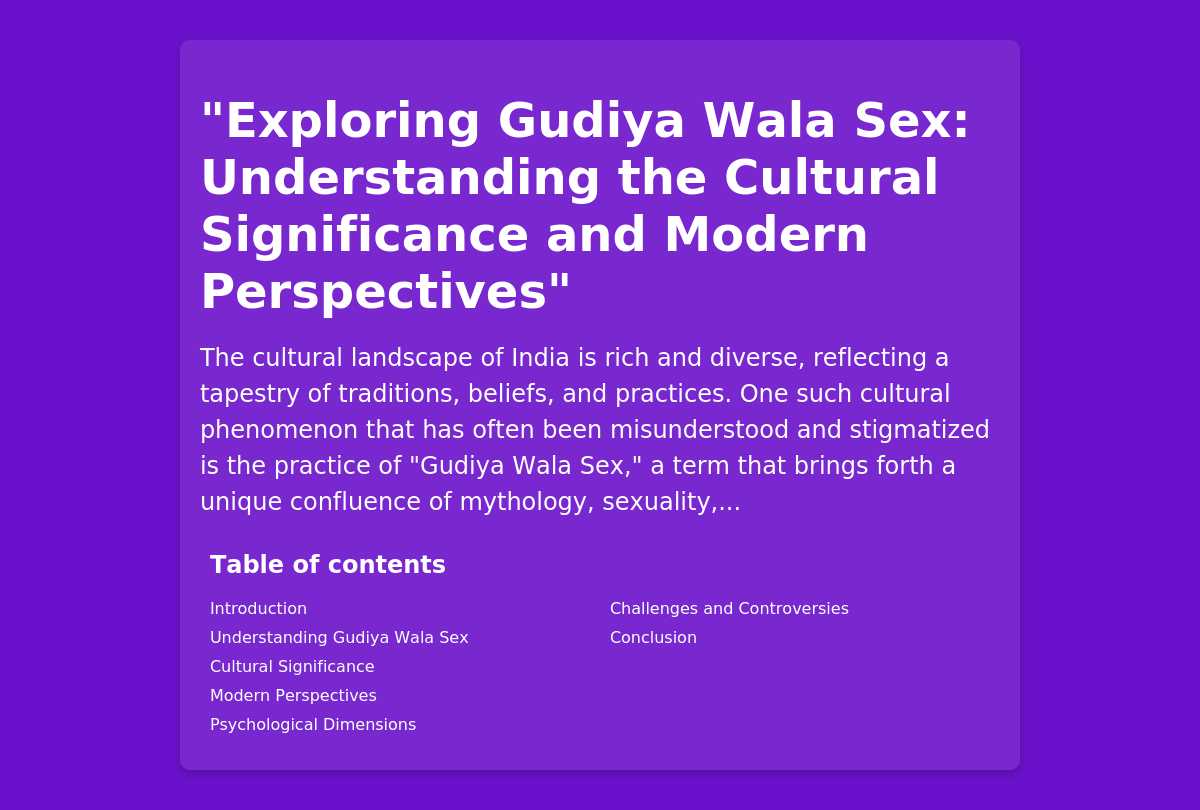Exploring Gudiya Wala Sex: Understanding the Cultural Significance and Modern Perspectives
Introduction
The cultural landscape of India is rich and diverse, reflecting a tapestry of traditions, beliefs, and practices. One such cultural phenomenon that has often been misunderstood and stigmatized is the practice of “Gudiya Wala Sex,” a term that brings forth a unique confluence of mythology, sexuality, and societal norms. This article seeks to explore Gudiya Wala Sex, delving into its cultural significance, historical context, and the modern perspectives surrounding it.
Understanding Gudiya Wala Sex
What is Gudiya Wala Sex?
Gudiya Wala Sex can be described as a ritualistic practice found in various communities in India, notably among certain tribes and folk traditions. The term “Gudiya” translates to “doll” in Hindi, symbolizing the innocence and purity often associated with childhood. However, the connotation in this context extends far beyond play, showcasing a complex interaction between gender, sexuality, and societal structure.
This practice often involves sexual expression intertwined with traditional beliefs, where dolls or effigies are used in ritualistic ceremonies. The nuances of this practice vary significantly from one community to another, often reflecting their unique ethos and social norms.
Historical Context
The historical roots of Gudiya Wala Sex can be traced back to ancient Indian traditions where fertility rites, worship of feminine energy, and the celebration of sexual expression were common. In many cultures across the world, dolls have been used as objects of desire, reflection, and fantasy. In the Indian context, the interplay between sexuality and spirituality is deeply embedded within various rituals.
Origins in Folklore
Folklore provides a rich repository of narratives that often incorporate themes of sexuality, transformation, and gender dynamics. The following table summarizes key elements related to Gudiya Wala Sex as reflected in Indian folklore:
| Element | Description |
|---|---|
| Dolls | Symbolize innocence, femininity, and fertility |
| Rituals | Often held during festivals or auspicious occasions |
| Myths | Stories involving deities, love, and desire |
| Gender Roles | Reflect cultural attitudes towards masculinity and femininity |
Cultural Significance
Intersection of Gender and Sexuality
Gudiya Wala Sex provides a lens through which we can analyze the role of gender and sexuality in Indian society. The practice often involves a reimagining of gender roles and the dynamic between male and female identities. In many communities, the ritual acts as a space for exploring sexuality within the purview of cultural regulations.
Community Rituals and Celebratory Practices
In several tribes, Gudiya Wala Sex is not solely about sexual expression; it also includes celebrations, communal gatherings, and rituals that signify communal harmony and collective identity. By engaging in these practices, participants reinforce community bonds and promote social cohesion.
Comparative Example
To understand the cultural significance of Gudiya Wala Sex, it is useful to compare it with similar practices in other cultures. The table below summarizes various global practices related to doll rituals and their cultural implications:
| Culture | Practice | Cultural Implication |
|---|---|---|
| Japan | Hina Matsuri (Doll Festival) | Celebration of girl’s health and happiness |
| Mexico | Day of the Dead (Dolls as Offering) | Honoring ancestors and spiritual connection |
| African Cultures | Fertility Dolls | Acknowledgment of fertility and womanhood |
Modern Perspectives
Shifting Attitudes Towards Sexuality
With globalization and the advent of technology, societal attitudes towards sex and sexuality have begun to shift. The modern discourse encompasses a myriad of influences that challenge traditional norms, including sexual liberation movements and the democratization of information. These shifts have influenced how practices like Gudiya Wala Sex are perceived in contemporary society.
Gudiya Wala Sex in Contemporary Media
Media representations play a critical role in shaping public perceptions about cultural practices. Cinematic portrayals, literature, and social media are beginning to challenge the stigmatization surrounding Gudiya Wala Sex, creating platforms for dialogue and understanding.
The Role of Art and Literature
Art and literature have the power to reshape narratives surrounding taboo subjects. Contemporary artists and writers often explore themes related to Gudiya Wala Sex, thereby elevating the discourse and encouraging acceptance. The following table outlines notable works and their themes:
| Artist/Literature | Work | Theme |
|---|---|---|
| Kamala Das | “My Story” | Female desire and sexual freedom |
| Aditi Rao Hydari | “The Girl with the Dragon Tattoo” | Cultural conflicts and sexual identity |
| Traditional Folk Artists | Various Paintings | Representation of femininity and traditions |
Psychological Dimensions
Sexuality and Psychological Well-being
Exploring Gudiya Wala Sex opens doors for discussions surrounding psychological implications. For many individuals, cultural practices serve as avenues of self-expression and exploration of identity.
The Therapeutic Aspect
Engagement in such culturally significant rituals can provide therapeutic benefits, offering participants a sense of belonging and acceptance. Psychologists view these practices as means for individuals to negotiate their sexual identities within their cultural framework.
Gender Identity and Perception
The interplay between Gudiya Wala Sex and gender identity raises intriguing questions regarding societal notions of masculinity and femininity. Traditional constructs often dictate rigid gender roles, yet these practices invite individuals to transcend such boundaries.
Challenges and Controversies
Societal Stigma
Despite its rich cultural heritage, Gudiya Wala Sex faces significant societal stigma. Misunderstandings and lack of awareness often lead to discrimination and ostracism. Addressing these issues requires a concerted effort to educate communities and foster open dialogue.
Conflict with Modernity
The tension between traditional practices and modern values presents challenges for practitioners of Gudiya Wala Sex. Balancing cultural heritage with contemporary societal expectations can create a sense of conflict for individuals, particularly in urban areas.
Comparative Analysis of Acceptance
In examining the challenges faced by Gudiya Wala Sex, it is prudent to analyze similar practices facing societal resistance. The following table elucidates various cultural practices and the challenges they face in modern contexts:
| Cultural Practice | Challenge | Impact on Community |
|---|---|---|
| Same-Sex Relationships | Legal and social discrimination | Marginalization and social isolation |
| Ritualistic Body Art | Stigmatization and labeling | Suppression of cultural expression |
| Alternative Lifestyles | Resistance from traditionalist groups | Tensions within community values |
Conclusion
Exploring Gudiya Wala Sex reveals the complexities surrounding cultural practices, sexuality, and gender identity in contemporary society. As dialogues evolve, there is a growing recognition of the need to embrace, understand, and respect diverse cultural expressions.
By expanding the conversation around Gudiya Wala Sex, we can contribute to a more tolerant and inclusive society, where individuality is celebrated, and cultural practices are understood in their full context. Through awareness and education, we can dismantle societal stigma and foster a greater appreciation for the myriad ways in which culture shapes our understanding of sexuality.
Share with PDF: Download












Leave a Reply